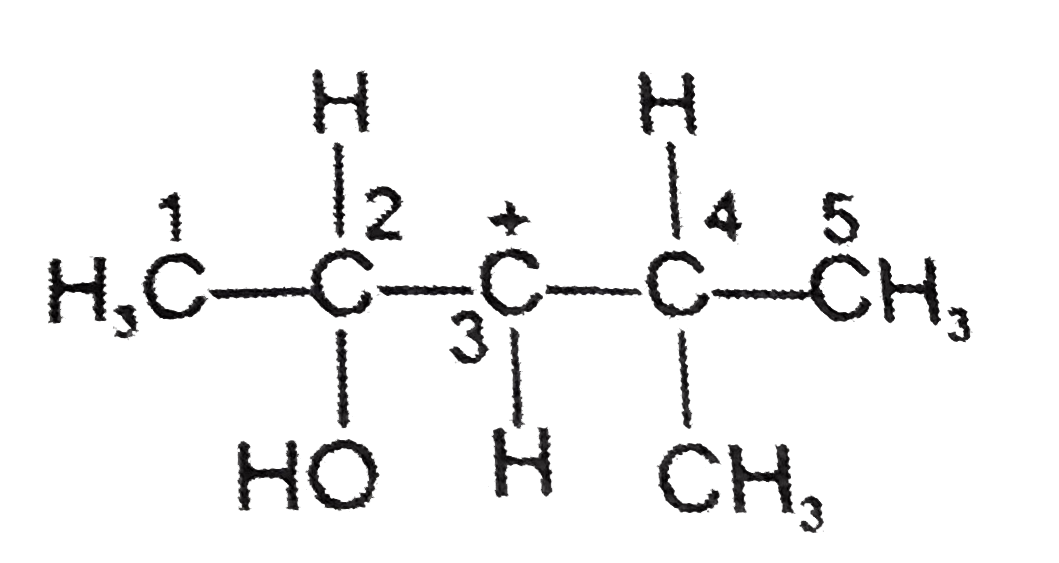The carbocation (CH3)3C+ is stabilized primarily by
hyperconjugation
tautomerism
resonance
conjugation
The correct Answer is:A
To determine how the carbocation (CH₃)₃C⁺ is stabilized, we can follow these steps:
1. Identify the Structure of the Carbocation:
The given carbocation is (CH₃)₃C⁺, which can be represented as:
CH₃∣CH₃−C⁺−CH₃
Here, the central carbon atom carries a positive charge and is bonded to three methyl groups (CH₃).
2. Understand Carbocation Stability:
The stability of carbocations is influenced by various factors, including hyperconjugation, resonance, and inductive effects. Among these, hyperconjugation plays a significant role in stabilizing carbocations.
3. Count the Alpha Hydrogens:
Alpha hydrogens are the hydrogens attached to the carbon atoms adjacent to the positively charged carbon. In this case, each of the three methyl groups contributes three alpha hydrogens:
- From each CH₃ group, we have 3 alpha hydrogens.
- Total alpha hydrogens = 3 (from first CH₃) + 3 (from second CH₃) + 3 (from third CH₃) = 9 alpha hydrogens.
4. Explain Hyperconjugation:
Hyperconjugation occurs when the sigma bonds (C-H) of the adjacent methyl groups can donate electron density to the empty p-orbital of the positively charged carbon. This delocalization of charge helps to stabilize the carbocation.
5. Evaluate Other Stabilization Effects:
- Tautomerism: This does not apply to this carbocation, as there are no keto-enol forms present.
- Resonance: There are no double bonds or conjugated systems in this structure to allow for resonance stabilization.
- Conjugation: Similar to resonance, there are no double bonds present that would allow for conjugation.
6. Conclusion:
Since hyperconjugation is the primary stabilizing factor for the carbocation (CH₃)₃C⁺, the correct answer is hyperconjugation.
Final Answer:
The carbocation (CH₃)₃C⁺ is stabilized primarily by hyperconjugation.
The given carbocation is (CH₃)₃C⁺, which can be represented as:
CH₃∣CH₃−C⁺−CH₃
Here, the central carbon atom carries a positive charge and is bonded to three methyl groups (CH₃).
The stability of carbocations is influenced by various factors, including hyperconjugation, resonance, and inductive effects. Among these, hyperconjugation plays a significant role in stabilizing carbocations.
Alpha hydrogens are the hydrogens attached to the carbon atoms adjacent to the positively charged carbon. In this case, each of the three methyl groups contributes three alpha hydrogens:
- From each CH₃ group, we have 3 alpha hydrogens.
- Total alpha hydrogens = 3 (from first CH₃) + 3 (from second CH₃) + 3 (from third CH₃) = 9 alpha hydrogens.
Hyperconjugation occurs when the sigma bonds (C-H) of the adjacent methyl groups can donate electron density to the empty p-orbital of the positively charged carbon. This delocalization of charge helps to stabilize the carbocation.
- Tautomerism: This does not apply to this carbocation, as there are no keto-enol forms present.
- Resonance: There are no double bonds or conjugated systems in this structure to allow for resonance stabilization.
- Conjugation: Similar to resonance, there are no double bonds present that would allow for conjugation.
Since hyperconjugation is the primary stabilizing factor for the carbocation (CH₃)₃C⁺, the correct answer is hyperconjugation.
The carbocation (CH₃)₃C⁺ is stabilized primarily by hyperconjugation.
Topper's Solved these Questions
- GENERAL ORGANIC CHEMISTRY IIBOOK - RESONANCE ENGLISHCHAPTER - GENERAL ORGANIC CHEMISTRY IIEXERCISE - Part-III: Practice Test-2 (IIT-JEE (Advanced Pattern))
16 Videos
- GENERAL ORGANIC CHEMISTRY IIBOOK - RESONANCE ENGLISHCHAPTER - GENERAL ORGANIC CHEMISTRY IIEXERCISE - Part-III: Section-4 : Comprehension Type
3 Videos
- GENERAL ORGANIC CHEMISTRY IIBOOK - RESONANCE ENGLISHCHAPTER - GENERAL ORGANIC CHEMISTRY IIEXERCISE - (APSP) Part-I:Practice Test-1
30 Videos
- GASEOUS STATEBOOK - RESONANCE ENGLISHCHAPTER - GASEOUS STATEEXERCISE - ORGANIC CHEMISTRY(Hydrocarbon)
18 Videos
- GENERAL ORGANIC CHEMISTRY-IBOOK - RESONANCE ENGLISHCHAPTER - GENERAL ORGANIC CHEMISTRY-IEXERCISE - PART-III : PRACTICE TEST-19
1 Videos
Similar Questions
Knowledge Check
The carbocation CH3+CHCH3 is less stable than
ACH3CH2+CH2B+CH2C(CH3)3+CDCH3+CH2Which carbocation is the most stabilized ?
A B
B C
C D
D
The order of decreasing stability of the following carbanions is
(i) (CH3)3C−
(ii) (CH3)2CH−
(iii) CH3CH−2
(iv) C6H5CH−2A(i)gt(ii)gt(iii)gt(iv)B(iv)gt(iii)gt(ii)gt(i)C(iv)gt(i)gt(ii)gt(iii)D(iii)gt(ii)gt(i)gt(Iv)
Arrange the carbanions, (CH3)3¯¯¯C,¯¯¯CCl3,(CH3)2¯¯¯CH,C6H5¯¯¯CH2, in order of their decreasing stability
View SolutionArrange the carbanions, (CH3)3¯¯¯C,¯¯¯CCl3,(CH3)2¯¯¯CH,C6H5¯¯¯CH2, in order of their decreasing stability
View SolutionArrange .the following in increasing order of stability of carbocation.
(a) (CH3)2C−CH2CH3
(b) (CH3)3C
(c) (CH3)2CH
(d) CH3CH2
View SolutionArrange the following carbocations in increasing order of stability and mention basis of the order suggested
(i) ⊕CH3 (ii) CH3⊕CH2 (iii) CH3⊕CHCH3 (iv) CH3−⊕C∣CH3−CH3
View SolutionArrange the following carbocations in increasing order of stability and mention basis of the order suggested
(i) ⊕CH3 (ii) CH3⊕CH2 (iii) CH3⊕CHCH3 (iv) CH3−⊕C∣CH3−CH3
View Solution

